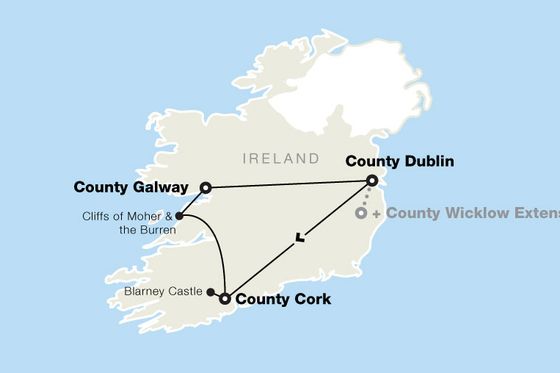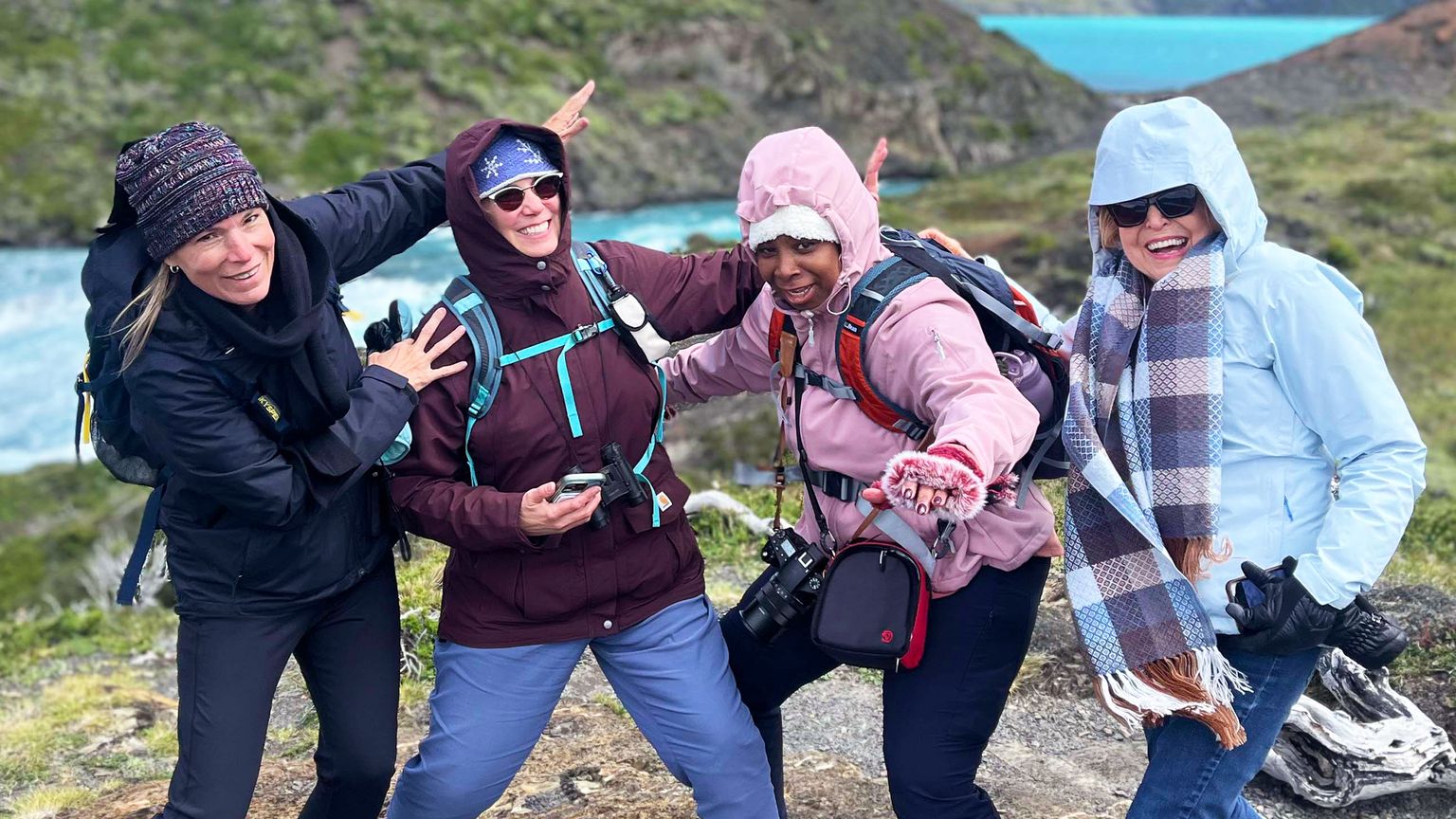
The ultimate Ireland Travel Guide: expert tips to plan your next trip
From rolling sheep-dotted hills to lively towns, sunny beaches, cliffs, castles, and churches, Ireland offers endless sights and experiences on a tour.
You’ll understand why Ireland is called the Emerald Isle when you first see its verdant countryside, unfurling like a lush green carpet, from the window of your plane. But you’ll really understand the poetic name once you’re on the ground, exploring the hidden gems that make Ireland a magical jewel of a destination.
Many travelers don’t go beyond Dublin, and while the city is absolutely a must-visit, Ireland offers so much more. It’s a country whose cultural heritage and traditions are as rich as its landscapes are diverse. From visiting rolling sheep-dotted hills to lively centuries-old towns, sunny beaches to vertigo-inducing cliffs, ancient castles and churches to, well, more castles and churches, there’s so much to do and see on a tour of Ireland.
Currency: Euro
Language: English is Ireland’s main language, and all native Irish people can speak English. However, you’ll see some signs and place names in Irish Gaelic.
Getting around: The easiest, most reliable way to get around Ireland is via public transportation, and the island is small enough that few journeys last more than three hours or so. (That’s the length of the train ride between Dublin and Cork, for instance.) While Ireland’s bus network is more extensive than its rail network, train travel is generally faster.
Phrases to know: “What’s the craic?” (pronounced crack) is how the Irish ask, “What’s up?” You’ll hear the word “craic” a lot, as it can refer to everything from music to good conversation. When you’re at a pub, ask for a “pint of gat”—that is, a pint of Guinness. And to toast the new friends you’ll undoubtedly make in Ireland—whether you’re a solo traveler or part of an educational tour—say, “Sláinte!” (pronounced slawn-cha), or “health.”

When to go to Ireland
Thanks to its mild, temperate climate, the best time to visit Ireland is, well, any time! Rain is common year-round, but days below freezing are as rare as those that’ll have you wishing for air conditioning. Still, there are certain times of year when a trip to Ireland is particularly special.
- St. Patrick’s Day in Dublin is more than a day, both literally and metaphorically. It’s a five-day celebration of Irish pride that unites old traditions with modern revelry. The Temple Bar neighborhood is the green, white, and orange epicenter of the legendary St. Patrick’s Day parade, but you can be as festive as you want anywhere in the city. We can’t think of many places more vibrant than the Irish capital on St. Patrick’s Day.
- Mid-April through May is when Ireland is at its most colorful, with flowers blooming and grass looking technicolor green. Plus, you’ll avoid the biggest peak travel-season crowds that arrive in summer.
- Summer, despite its increased crowds and prices, offers long, warm days. In late June and early July, the sun doesn’t set until roughly 10 p.m. If you need convincing, we’ve got eight reasons why you can’t miss summer in Ireland.

What to pack for a trip to Ireland
Packing for a trip to Ireland means preparing for the unpredictable. But, as experienced travelers always say: There’s no bad weather, just bad preparation.
- Layers. Ireland’s weather can keep you guessing. You might experience multiple seasons in a single day—a wind-whipped morning, a blue-sky afternoon, a downpour at night—so pack lightweight clothing that’s easy to layer and wicks moisture.
- A windproof umbrella, waterproof jacket, and rain boots for those wet, windy days. You’ll appreciate them most when along the coast.
- Comfortable walking shoes, because Ireland is best explored on foot.

The best things to do in Ireland
One trip isn’t enough to experience all that Ireland has to offer. But our travelers have a few recommendations for can't-miss things to do and places to visit in Ireland.
- Hear traditional Irish music in the form of a “trad session”—a loosely organized, sometimes impromptu live performance—at an old-fashioned pub. Our favorite pubs in Ireland will do the trick.
- Drive the Wild Atlantic Way. True to its name, the winding, 1,550-mile route along Ireland’s western coastline is rugged and untamed. But the Wild Atlantic Way has more than just scenic views (though they’d be enough on their own). Between long stretches of natural splendor are little cliff-top villages and seaside towns and cities that offer a window into the Irish way of life. Wondering what our tour of the Wild Atlantic Way is like? Check out a virtual tour in advance.
- Walk along the Cliffs of Moher for some of the most purely beautiful vistas in all of Ireland. Offering uninterrupted views of the Atlantic Ocean and the Aran Islands from hundreds of feet up, these cliffs are a longtime favorite among travelers.
- Tour the Kilmainham Gaol for a sobering, fascinating window into Ireland’s history. The prison opened in 1796, and it famously housed Nelson Mandela, among other revolutionaries and political prisoners. Kilmainham is one of our top recommendations in Dublin.
- Explore the medieval town of Kilkenny. Walking the central Medieval Mile, seeing Kilkenny Castle, and looking down on the town from the Gothic St. Canice’s cathedral will have you feeling like a time traveler. Don’t miss the nearby Rock of Cashel, an ancient hilltop fortress. Fortunately, all these places are on our Traditions of the Emerald Isle tour!
- Kiss the Blarney Stone to gain the gift of gab at the 600-year-old Blarney Castle.
- Travel around the Ring of Kerry, a 112-mile coastal route that winds through some of Ireland’s most spectacular scenery, such as Killarney National Park. Tucked among the park’s mountains and lakes is Muckross House, a 19th-century Victorian mansion and open-air museum. The Ring of Kerry is one of the focal points of our Grand Tour of Ireland.

Where and what to eat and drink in Ireland
Irish cuisine isn’t just Guinness and fish and chips! Ireland might not have the same culinary reputation as, say, France or Italy, but with the country’s thriving farm- and sea-to-table movement and a rich tradition of hearty meals, you won’t go hungry. The best restaurants in Dublin, especially, will make you rethink your preconceived ideas about Irish food.
- Tig Cóilí is a cozy pub that hosts impromptu trad sessions. Twice a day, tourists and locals alike get the chance to hear traditional Irish music, sometimes played by famous musicians. It’s so popular that you might not find a seat, but saddle up to the bar and the friendly bartenders will welcome you.
- The Brazen Head is Ireland’s oldest pub, dating back to 1198. Follow in the footsteps of literary icons Jonathan Swift and James Joyce (he references the pub in Ulysses) by enjoying a pint in the Brazen Head’s warm, inviting atmosphere. The traditional Irish stew, with lamb and vegetables and mashed potatoes, is a winner. The beef-and-Guinness stew, too.
- Guinness Storehouse. If you visit Dublin without having a dark, frothy pint of Ireland’s most iconic beer at the home of Guinness, did you really visit Dublin? What was once the fermentation plant of the Guinness brewery is now a seven-floor interactive experience that takes you through the history of the beer. On the top floor is the Gravity Bar, which offers 360-degree panoramic views of Dublin from one of the city’s highest points. The best rooftop bar in the city? Probably!
- Chapter One. Warm Irish hospitality. Inventively modern Irish cooking. A stylish, art-filled space directly beneath a museum devoted to Ireland’s rich literary history. Combine them all and you get Chapter One—one of Ireland’s 13 restaurants with a coveted Michelin star. It’s not cheap, of course, but if there’s anywhere to splurge on a memorable, hours-long Dublin meal, this is the place.
- Irish whiskey. We’re not encouraging you to go overboard, of course! But whiskey is Ireland’s most famous alcoholic export, and visiting a distillery is a fun and educational way to experience Ireland’s culture. (And impress your friends back home with your new knowledge about tasting notes.) Jameson, Teeling, and Roe & Co.—three of the biggest names in Irish whiskey—have distilleries in Dublin.
- Fish and chips at a chipper or a full Irish breakfast are classic, filling meals. Meat and seafood are Ireland’s specialties. Anthony Bourdain loved the Irish breakfast at the 200-year-old Slattery’s Bar in Dublin, and we’re sure you will too.
 .
.
The best Irish souvenirs
You can bring home more than memories from your trip to Ireland. These special souvenirs will remind you (and your loved ones) of the Emerald Isle.
- Irish whiskey is an obvious choice, but make sure to buy some rare or special whiskey that can’t be purchased (or afforded) back home.
- Aran wool sweaters, the traditional knitwear from the Aran Islands, off Ireland’s west coast. Also known as fishermen sweaters, they’re a symbol of Irish heritage that’s as warm and rugged as the country itself. You can find them for sale all over.
- Irish tea and tea sets, to remind you of those ample Irish breakfasts.
- Irish chocolate makes for a sweet souvenir. Cadbury Dairy Milk chocolate is a rich, creamy Irish favorite.
Explore all of our Ireland tours today. Then, head to our Facebook page to talk travel with other Ireland lovers.









































































)






